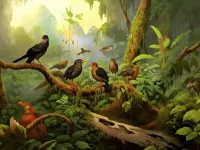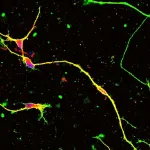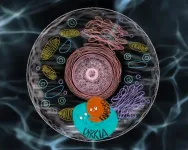(Press-News.org) WASHINGTON, Dec. 19, 2023 – A winter wonderland calls to mind piles of fluffy, glistening snow. But to reach the ground, snowflakes are swept into the turbulent atmosphere, swirling through the air instead of plummeting directly to the ground.
The path of precipitation is complex but important to more than just skiers assessing the potential powder on their alpine vacation or school children hoping for a snow day. Determining snowflake fall speed is crucial for predicting weather patterns and measuring climate change.
In Physics of Fluids, from AIP Publishing, researchers from the University of Utah report snowflake accelerations in atmospheric turbulence. They found that regardless of turbulence or snowflake type, acceleration follows a universal statistical pattern that can be described as an exponential distribution.
“Even in the tropics, precipitation often starts its lifetime as snow,” said author Timothy Garrett. “How fast precipitation falls greatly affects storm lifetimes and trajectories and the extent of cloud cover that may amplify or diminish climate change. Just small tweaks in model representations of snowflake fall speed can have important impacts on both storm forecasting and how fast climate can be expected to warm for a given level of elevated greenhouse gas concentrations.”
Set up in a ski area near Salt Lake City, the team battled an unprecedented 900 inches of snow. They simultaneously filmed snowfall and measured atmospheric turbulence. Using a device they invented that employs a laser light sheet, they gathered information about snowflake mass, size, and density.
“Generally, as expected, we find that low-density ‘fluffy’ snowflakes are most responsive to surrounding turbulent eddies,” said Garrett.
Despite the system’s complexity, the team found that snowflake accelerations follow an exponential frequency distribution with an exponent of three halves. In analyzing their data, they also discovered that fluctuations in the terminal velocity frequency distribution followed the same pattern.
“Snowflakes are complicated, and turbulence is irregular. The simplicity of the problem is actually quite mysterious, particularly given there is this correspondence between the variability of terminal velocities – something ostensibly independent of turbulence – and accelerations of the snowflakes as they are locally buffeted by turbulence,” said Garrett.
Because size determines terminal velocity, a possible explanation is that the turbulence in clouds that influences snowflake size is related to the turbulence measured at the ground. Yet the factor of three halves remains a mystery.
The researchers will revisit their experiment this winter, using a mist of oil droplets to obtain a closer look at turbulence and its impact on snowflakes.
###
The article “A universal scaling law for Lagrangian snowflake accelerations in atmospheric turbulence” is authored by Dhiraj Kumar Singh, Eric R. Pardyjak, and Timothy Garrett. It will appear in Physics of Fluids on Dec. 19, 2023 (DOI: 10.1063/5.0173359). After that date, it can be accessed at https://doi.org/10.1063/5.0173359.
ABOUT THE JOURNAL
Physics of Fluids is devoted to the publication of original theoretical, computational, and experimental contributions to the dynamics of gases, liquids, and complex fluids. See https://pubs.aip.org/aip/pof.
###
END
Snowflakes swirling in turbulent air as they fall through a laser light sheet. Credit: Singh et al.
Snowflake accelerations mysteriously follow a predictable pattern.
2023-12-19
ELSE PRESS RELEASES FROM THIS DATE:
Clinicians could be fooled by biased AI, despite explanations
2023-12-19
AI models in health care are a double-edged sword, with models improving diagnostic decisions for some demographics, but worsening decisions for others when the model has absorbed biased medical data.
Given the very real life and death risks of clinical decision-making, researchers and policymakers are taking steps to ensure AI models are safe, secure and trustworthy—and that their use will lead to improved outcomes.
The U.S. Food and Drug Administration has oversight of software powered by AI and machine learning used in health care and has issued guidance for developers. This includes a call to ensure the ...
Measuring the impact of AI in the diagnosis of hospitalized patients
2023-12-19
About The Study: Although standard artificial intelligence (AI) models improve diagnostic accuracy, systematically biased AI models reduced diagnostic accuracy, and commonly used image-based AI model explanations did not mitigate this harmful effect in this multicenter randomized clinical vignette survey study involving hospitalist physicians, nurse practitioners, and physician assistants from 13 states.
Authors: Michael W. Sjoding, M.D., of the University of Michigan Medical School, and Jenna Wiens, Ph.D., of the University of Michigan, Ann Arbor, are the corresponding authors.
To ...
Disparities in preoperative goals of care documentation in veterans
2023-12-19
About The Study: In this study of 13,000 patients, few patients undergoing surgical procedures completed preoperative life-sustaining treatment documentation, with disparities in documentation rates based on race, ethnicity, rurality of patient residence, history of mental health disability, and access to high-volume facilities within a Veterans Affairs cohort.
Authors: Adela Wu, M.D., of the U.S. Department of Veterans Affairs, in Palo Alto, California is the corresponding author.
To access the embargoed study: Visit our For The Media website at this link https://media.jamanetwork.com/
(doi: ...
Screening for social determinants of health during primary care and emergency department encounters
2023-12-19
About The Study: This study found that patients screened in the emergency department (ED) were more likely to screen positive for Social Determinants of Health (SDOH) needs, which is not surprising given utilization patterns. Patients with SDOH needs have limited health care access and are more likely to use the ED than primary care. Although primary care–based screening found lower SDOH needs relative to the ED, primary care may be better optimized to follow and ultimately address SDOH needs.
Authors: Stacie ...
Study uncovers major hidden human-driven bird extinctions
2023-12-19
Humans have wiped out around 1,400 bird species – twice as many as previously thought – with major implications for the ongoing biodiversity crisis, a new study has found.
Many of the world’s islands were previously untouched paradises, but the arrival of people to places like Hawaii, Tonga and the Azores led, over time, to far-reaching impacts including deforestation, overhunting and the introduction of invasive species. Consequently, bird species were wiped out.
While the demise of many birds since the 1500s has been recorded, our knowledge of the fate of species before this relies on fossils, ...
Promising new treatment for a common hereditary nerve disease
2023-12-19
Researchers from Tokyo Medical and Dental University (TMDU) develop a genome-editing technique that reduces disease-causing proteins and related issues in cells from a patient with Charcot–Marie–Tooth disease type 1A
Tokyo, Japan – Scientific advances in the last century have changed our world significantly. For example, the world of genetics has opened doors to a myriad of possibilities: augmented human capabilities, cures for diseases, and even changes to the course of evolution.
In a study published last month in Communications Medicine, researchers from Tokyo Medical and Dental University (TMDU) have unveiled a groundbreaking genome-editing technique. This ...
Moderation surpasses excess
2023-12-19
Kyoto, Japan -- Down syndrome, a congenital disorder stemming from abnormal cell division and differentiation, is most common in newborns fated to neurodevelopmental delays and other health complications.
The genetic defect causes the dysfunction of the protein kinase DYRK1A, which is encoded on chromosome 21 and is deeply associated with both Down syndrome and autism spectrum disorder. DYRK1A has attracted attention as a target molecule for treating various diseases, but specific cellular mechanisms regulating ...
Linking genes and brain circuitry in anxiety disorders
2023-12-19
Kyoto, Japan – December 2023
Anxiety disorders (ADs) affect more than 280 million people worldwide, making them one of the most common mental health conditions. ADs have a genetic basis as seen from inheritance in families, and people with one subtype of AD tend to have another subtype, suggesting a shared genetic basis. Although the brain circuitry involved in ADs has been identified, its link with gene expression remains unclear. Two researchers at Kyoto University in Japan set out to uncover this link and found two gene clusters expressed in ...
A bacterial toolkit for colonizing plants
2023-12-19
Using a novel experimental approach, Max Planck researchers have discovered a core set of genes required by commensal bacteria to colonize their plant hosts. The findings may have broad relevance for understanding how bacteria establish successful host–commensal relationships.
Plants are colonized by an enormous variety of microorganisms, including bacteria, archaea and fungi, that form complex communities, or microbiomes, on their roots and organs. Although invisible to the naked eye, the importance of these tiny inhabitants should not be underestimated. They play a crucial role in plant nutrition, influence the health of plants, strengthen their tolerance to stress factors such as ...
Study provides new insight into low social determinants of health screening rates
2023-12-19
A new study provides the latest data on the low rates for screening and documenting Social Determinants of Health (SDOH) in healthcare settings.
SDOHs are a person's social, environmental and economic conditions highly correlated with their health outcomes. This includes unemployment, homelessness and illiteracy, among many other factors. Although SDOHs can contribute to a more comprehensive understanding of a patient's health and inform important policy changes, clinical offices fall short of tracking this information.
To better understand ...
LAST 30 PRESS RELEASES:
Heart-brain connection: international study reveals the role of the vagus nerve in keeping the heart young
Researchers identify Rb1 as a predictive biomarker for a new therapeutic strategy in some breast cancers
Survey reveals ethical gaps slowing AI adoption in pediatric surgery
Stimulant ADHD medications work differently than thought
AI overestimates how smart people are, according to HSE economists
HSE researchers create genome-wide map of quadruplexes
Scientists boost cell "powerhouses" to burn more calories
Automatic label checking: The missing step in making reliable medical AI
Low daily alcohol intake linked to 50% heightened mouth cancer risk in India
American Meteorological Society announces Rick Spinrad as 2026 President-Elect
Biomass-based carbon capture spotlighted in newly released global climate webinar recording
Illuminating invisible nano pollutants: advanced bioimaging tracks the full journey of emerging nanoscale contaminants in living systems
How does age affect recovery from spinal cord injury?
Novel AI tool offers prognosis for patients with head and neck cancer
Fathers’ microplastic exposure tied to their children’s metabolic problems
Research validates laboratory model for studying high-grade serous ovarian cancer
SIR 2026 delivers transformative breakthroughs in minimally invasive medicine to improve patient care
Stem Cell Reports most downloaded papers of 2025 highlight the breadth and impact of stem cell research
Oxford-led study estimates NHS spends around 3% of its primary and secondary care budget on the health impacts of heat and cold in England
A researcher’s long quest leads to a smart composite breakthrough
Urban wild bees act as “microbial sensors” of city health.
New study finds where you live affects recovery after a hip fracture
Forecasting the impact of fully automated vehicle adoption on US road traffic injuries
Alcohol-related hospitalizations from 2016 to 2022
Semaglutide and hospitalizations in patients with obesity and established cardiovascular disease
Researchers ‘listen in’ to embryo-mother interactions during implantation using a culture system replicating the womb lining
How changing your diet could help save the world
How to make AI truly scalable and reliable for real-time traffic assignment?
Beyond fragmented markets: A new framework for efficient and stable ride-pooling
Can shape priors make road perception more reliable for autonomous driving?
[Press-News.org] Snowflakes swirling in turbulent air as they fall through a laser light sheet. Credit: Singh et al.Snowflake accelerations mysteriously follow a predictable pattern.





